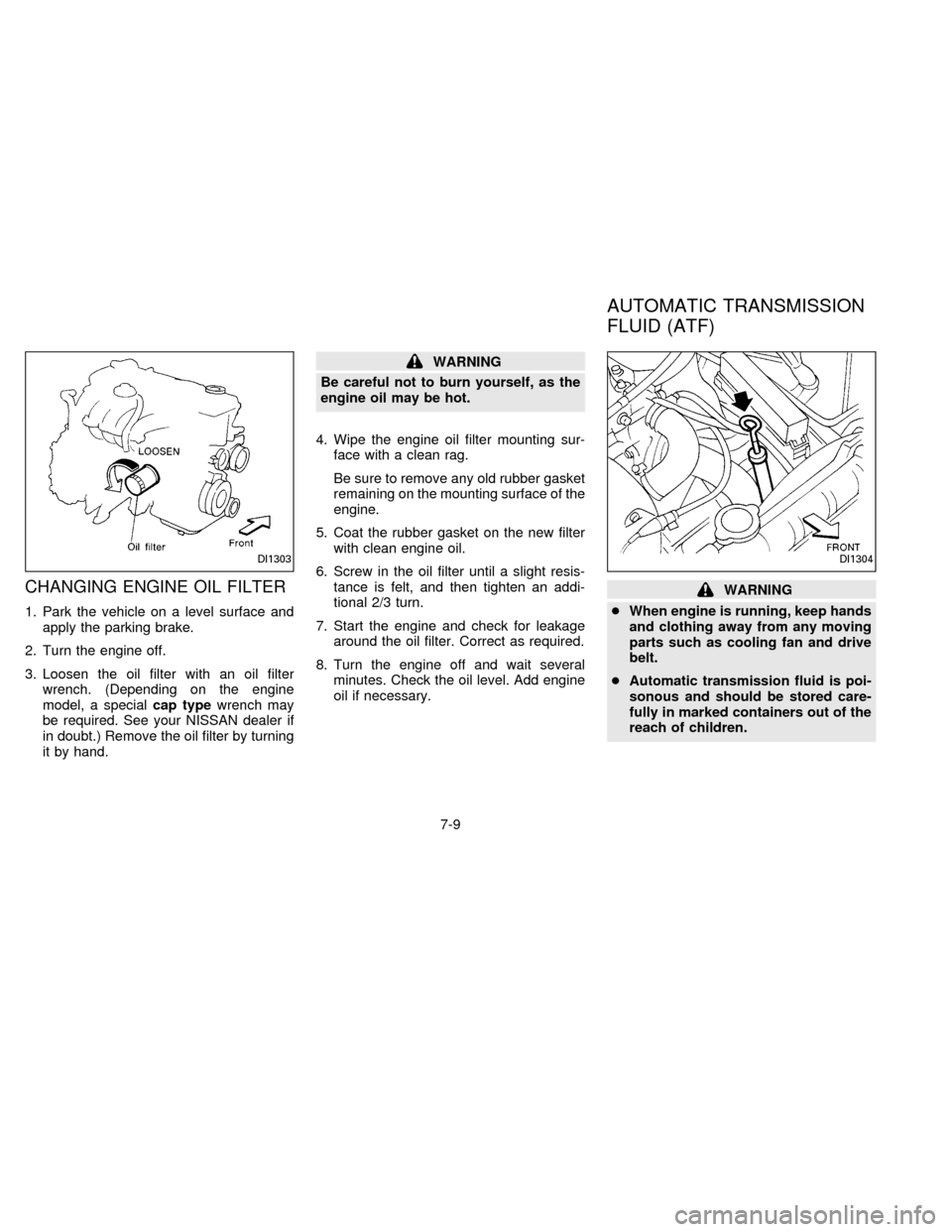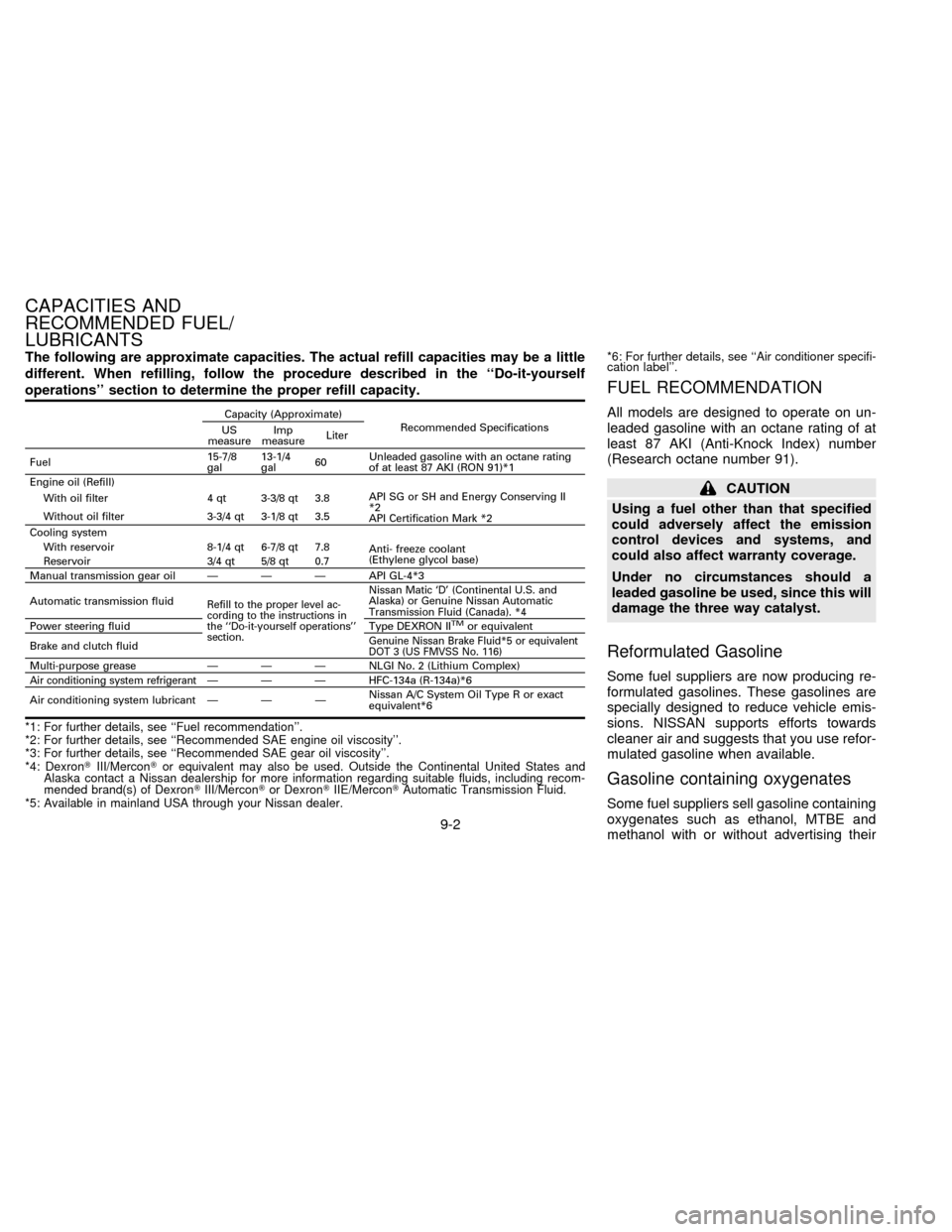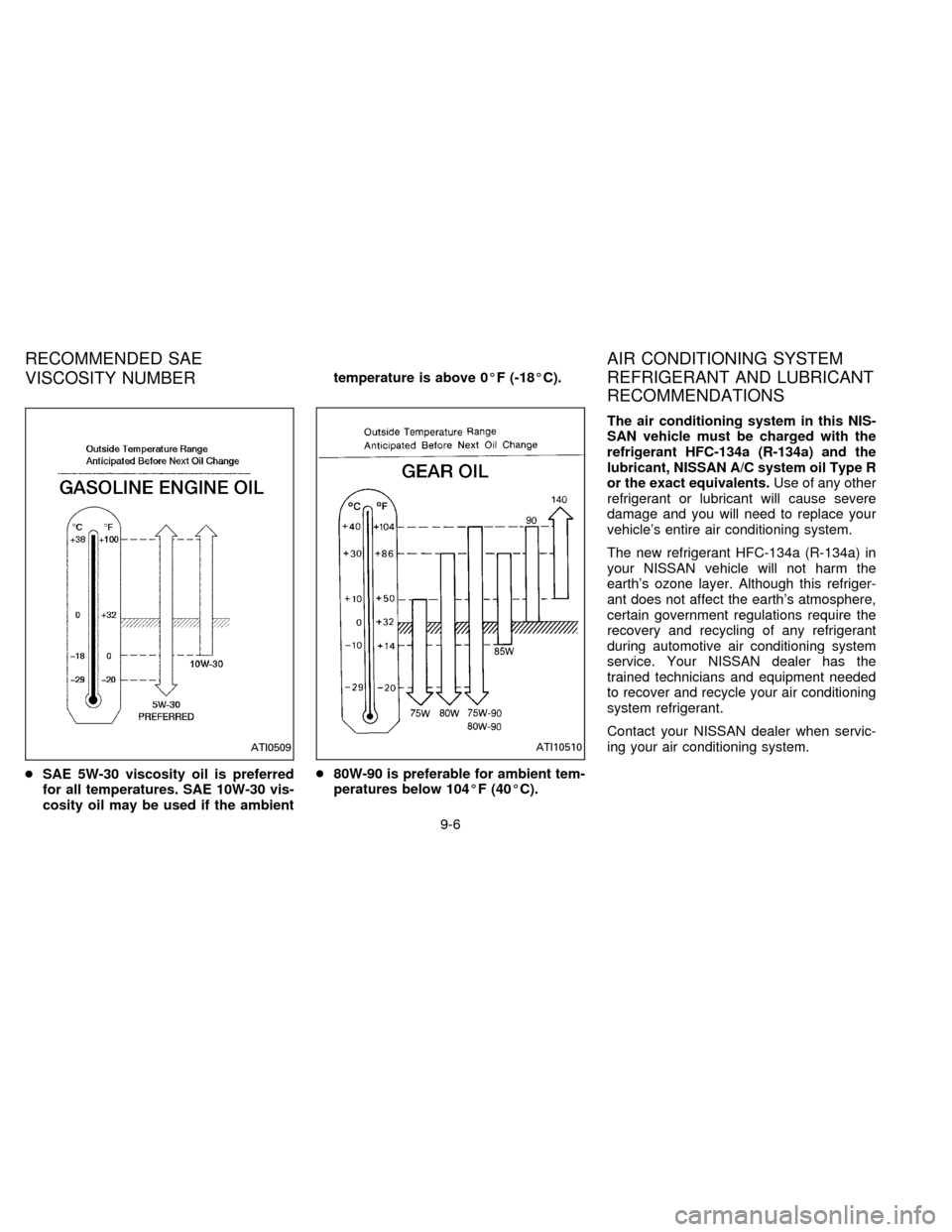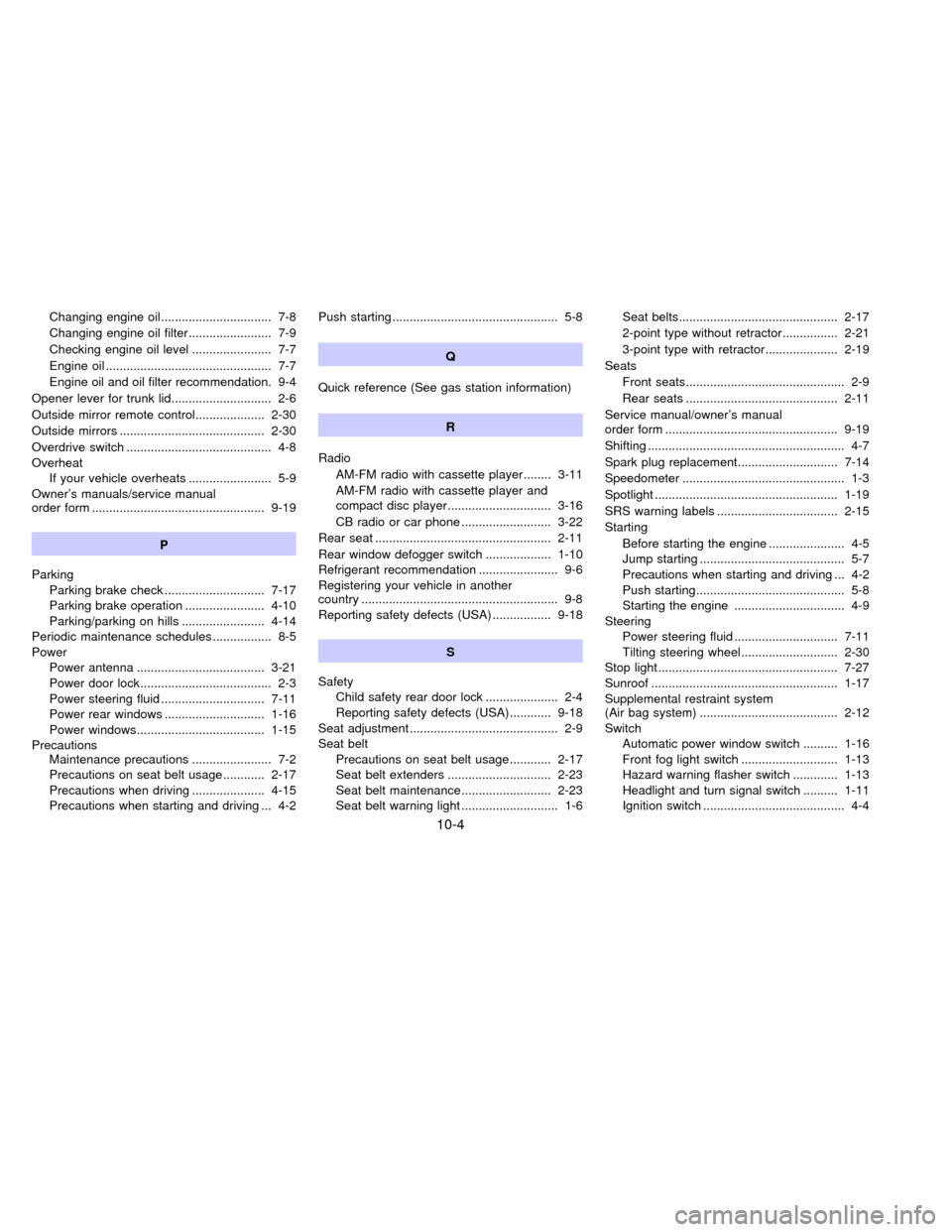1996 NISSAN ALTIMA oil type
[x] Cancel search: oil typePage 124 of 183

CHANGING ENGINE OIL FILTER
1. Park the vehicle on a level surface and
apply the parking brake.
2. Turn the engine off.
3. Loosen the oil filter with an oil filter
wrench. (Depending on the engine
model, a specialcap typewrench may
be required. See your NISSAN dealer if
in doubt.) Remove the oil filter by turning
it by hand.
WARNING
Be careful not to burn yourself, as the
engine oil may be hot.
4. Wipe the engine oil filter mounting sur-
face with a clean rag.
Be sure to remove any old rubber gasket
remaining on the mounting surface of the
engine.
5. Coat the rubber gasket on the new filter
with clean engine oil.
6. Screw in the oil filter until a slight resis-
tance is felt, and then tighten an addi-
tional 2/3 turn.
7. Start the engine and check for leakage
around the oil filter. Correct as required.
8. Turn the engine off and wait several
minutes. Check the oil level. Add engine
oil if necessary.
WARNING
cWhen engine is running, keep hands
and clothing away from any moving
parts such as cooling fan and drive
belt.
cAutomatic transmission fluid is poi-
sonous and should be stored care-
fully in marked containers out of the
reach of children.
DI1303DI1304
AUTOMATIC TRANSMISSION
FLUID (ATF)
7-9
ZX
Page 153 of 183
![NISSAN ALTIMA 1996 U13 / 1.G Owners Manual SCHEDULE 1
Abbreviations: R = Replace I = Inspect. Correct or replace if necessary. [ ]: At the mileage intervals only
MAINTENANCE OPERATIONMAINTENANCE INTERVAL
Perform at number of miles,
kilometers NISSAN ALTIMA 1996 U13 / 1.G Owners Manual SCHEDULE 1
Abbreviations: R = Replace I = Inspect. Correct or replace if necessary. [ ]: At the mileage intervals only
MAINTENANCE OPERATIONMAINTENANCE INTERVAL
Perform at number of miles,
kilometers](/manual-img/5/594/w960_594-152.png)
SCHEDULE 1
Abbreviations: R = Replace I = Inspect. Correct or replace if necessary. [ ]: At the mileage intervals only
MAINTENANCE OPERATIONMAINTENANCE INTERVAL
Perform at number of miles,
kilometers or months,
whichever comes first.Miles x 1,000 3.75 7.5 11.25 15 18.75 22.5 26.25 30 33.75 37.5 41.25 45 48.75 52.5 56.25 60
(km x 1,000) (6) (12) (18) (24) (30) (36) (42) (48) (54) (60) (66) (72) (78) (84) (90) (96)
Months 3 6 9 12 15 18 21 24 27 30 33 36 39 42 45 48
Emission control system maintenance
Drive belts See NOTE (1)I*
Air cleaner filter See NOTE (2) [R] [R]
Vapor linesI* I*
Fuel linesI* I*
Fuel filter See NOTE (3)*
Engine coolant See NOTE (4)*R*
Engine oilRRRRRRRRRRRRRRRR
Engine oil filter
(Use Nissan PREMIUM type or equivalent.)RRRRRRRRRRRRRRRR
Spark plugs[R] [R]
Intake & exhaust valve clearance See NOTE (5)
NO TE: (1) After 60,000 miles (96,000 km) or 48 months, inspect every 15,000 miles (24,000 km) or 12 months.
(2) If operating mainly in dusty conditions, more frequent maintenance may be required.
(3) If vehicle is operated under extremely adverse weather conditions or in areas where ambient temperatures are either
extremely low or extremely high, the filters might become clogged. In such an event, replace them immediately.
(4) After 60,000 miles (96,000 km) or 48 months, replace every 30,000 miles (48,000 km) or 24 months.
(5) If valve noise increases, inspect valve clearance.
* Maintenance items and intervals marked with ``*'' are recommended by NISSAN for reliable vehicle operation. The
owner need not perform such maintenance in order to maintain the emission warranty or manufacturer recall liability.
Other maintenance items and intervals are required.
8-6
ZX
Page 155 of 183
![NISSAN ALTIMA 1996 U13 / 1.G Owners Manual SCHEDULE 2
Abbreviations: R = Replace I = Inspect. Correct or replace if necessary. [ ]: At the mileage intervals only
MAINTENANCE OPERATIONMAINTENANCE INTERVAL
Perform at number of miles, kilometers NISSAN ALTIMA 1996 U13 / 1.G Owners Manual SCHEDULE 2
Abbreviations: R = Replace I = Inspect. Correct or replace if necessary. [ ]: At the mileage intervals only
MAINTENANCE OPERATIONMAINTENANCE INTERVAL
Perform at number of miles, kilometers](/manual-img/5/594/w960_594-154.png)
SCHEDULE 2
Abbreviations: R = Replace I = Inspect. Correct or replace if necessary. [ ]: At the mileage intervals only
MAINTENANCE OPERATIONMAINTENANCE INTERVAL
Perform at number of miles, kilometers or
months, whichever comes first.Miles x 1,000 7.5 15 22.5 30 37.5 45 52.5 60
(km x 1,000) (12) (24) (36) (48) (60) (72) (84) (96)
Months 6 12 18 24 30 36 42 48
Emission control system maintenance
Drive belts See NOTE (1)I*
Air cleaner filter[R] [R]
Vapor linesI* I*
Fuel linesI* I*
Fuel filter See NOTE (2)*
Engine coolant See NOTE (3)R*
Engine oilRRRRRRRR
Engine oil filter (Use Nissan PREMIUM type or equivalent.)RRRRRRRR
Spark plugs[R] [R]
Intake & exhaust valve clearance See NOTE (4)
NOTE: (1) After 60,000 miles (96,000 km) or 48 months, inspect every 15,000 miles (24,000 km) or 12 months.
(2) If vehicle is operated under extremely adverse weather conditions or in areas where ambient temperatures are either
extremely low or extremely high, the filters might become clogged. In such an event, replace them immediately.
(3) After 60,000 miles (96,000 km) or 48 months, replace every 30,000 miles (48,000 km) or 24 months.
(4) If valve noise increases, inspect valve clearance.
* Maintenance items and intervals marked with ``*'' are recommended by NISSAN for reliable vehicle operation. The
owner need not perform such maintenance in order to maintain the emission warranty or manufacturer recall liability.
Other maintenance items and intervals are required.
8-8
ZX
Page 159 of 183

The following are approximate capacities. The actual refill capacities may be a little
different. When refilling, follow the procedure described in the ``Do-it-yourself
operations'' section to determine the proper refill capacity.
Capacity (Approximate)
Recommended Specifications
US
measureImp
measureLiter
Fuel15-7/8
gal13-1/4
gal60Unleaded gasoline with an octane rating
of at least 87 AKI (RON 91)*1
Engine oil (Refill)
With oil filter 4 qt 3-3/8 qt 3.8API SG or SH and Energy Conserving II
*2
API Certification Mark *2 Without oil filter 3-3/4 qt 3-1/8 qt 3.5
Cooling system
With reservoir 8-1/4 qt 6-7/8 qt 7.8
Anti- freeze coolant
(Ethylene glycol base)
Reservoir 3/4 qt 5/8 qt 0.7
Manual transmission gear oilÐ Ð Ð API GL-4*3
Automatic transmission fluid
Refill to the proper level ac-
cording to the instructions in
the ``Do-it-yourself operations''
section.Nissan Matic `D' (Continental U.S. and
Alaska) or Genuine Nissan Automatic
Transmission Fluid (Canada). *4
Power steering fluid Type DEXRON IITMor equivalent
Brake and clutch fluidGenuine Nissan Brake Fluid*5 or equivalent
DOT 3 (US FMVSS No. 116)
Multi-purpose greaseÐ Ð Ð NLGI No. 2 (Lithium Complex)Air conditioning system refrigerantÐ Ð Ð HFC-134a (R-134a)*6
Air conditioning system lubricant Ð Ð ÐNissan A/C System Oil Type R or exact
equivalent*6
*1: For further details, see ``Fuel recommendation''.
*2: For further details, see ``Recommended SAE engine oil viscosity''.
*3: For further details, see ``Recommended SAE gear oil viscosity''.
*4: DexronTIII/MerconTor equivalent may also be used. Outside the Continental United States and
Alaska contact a Nissan dealership for more information regarding suitable fluids, including recom-
mended brand(s) of DexronTIII/MerconTor DexronTIIE/MerconTAutomatic Transmission Fluid.
*5: Available in mainland USA through your Nissan dealer.*6: For further details, see ``Air conditioner specifi-
cation label''.
FUEL RECOMMENDATION
All models are designed to operate on un-
leaded gasoline with an octane rating of at
least 87 AKI (Anti-Knock Index) number
(Research octane number 91).
CAUTION
Using a fuel other than that specified
could adversely affect the emission
control devices and systems, and
could also affect warranty coverage.
Under no circumstances should a
leaded gasoline be used, since this will
damage the three way catalyst.
Reformulated Gasoline
Some fuel suppliers are now producing re-
formulated gasolines. These gasolines are
specially designed to reduce vehicle emis-
sions. NISSAN supports efforts towards
cleaner air and suggests that you use refor-
mulated gasoline when available.
Gasoline containing oxygenates
Some fuel suppliers sell gasoline containing
oxygenates such as ethanol, MTBE and
methanol with or without advertising their
CAPACITIES AND
RECOMMENDED FUEL/
LUBRICANTS
9-2
ZX
Page 161 of 183

Incorrect ignition timing will result in knock-
ing, after-run or overheating. This in turn
may cause excessive fuel consumption or
damage to the engine. If any of the above
symptoms are encountered, have your ve-
hicle checked at a NISSAN dealer or other
competent service facility.
However, now and then you may notice
light spark knock for a short time while
accelerating or driving up hills. This is
no cause for concern, because you get
the greatest fuel benefit when there is
light spark knock for a short time under
heavy engine load.
ENGINE OIL AND OIL FILTER
RECOMMENDATION
Selecting the correct oil
It is essential to chose the correct quality
and viscosity oil to ensure satisfactory en-
gine life and performance. Nissan recom-
mends the use of a low friction oil (energy
conserving oil) in order to improve fuel
economy and conserve energy. Oils which
do not have the specified quality label
should not be used as they could cause
engine damage.Only those engine oils with the American
Petroleum Institute (API) CERTIFICATION
MARK on the front of the container should
be used. This type of oil supersedes the
existing API SG or SH and Energy Conserv-
ing II categories.
If you cannot find engine oil with the CER-
TIFICATION MARK, an API SG or SH and
Energy Conserving II oil with API Service
Symbol may be used. An oil with a single
designation ``SG'' or ``SH'', or in combina-
tion with other categories (for example,
``SG/CC'' or ``SG/CD'') may also be used if
one with the API CERTIFICATION MARK
ATI0507
9-4
ZX
Page 162 of 183

cannot be found.
Mineral based or synthetic type oils may be
used in your NISSAN vehicle. These oils
must however, meet the API quality and
SAE viscosity ratings specified for your ve-
hicle. Do not mix mineral based and syn-
thetic type oils in the engine at the same
time.
Oil additives
NISSAN does not recommend the use of oil
additives. The use of an oil additive is not
necessary when the proper oil type is used
and maintenance intervals are followed.
Oil which may contain foreign matter or has
been previously used should not be used.
Oil viscosity
The engine oil viscosity or thickness
changes with temperature. Because of this,
it is important that the engine oil viscosity be
selected based on the temperatures at
which the vehicle will be operated before
the next oil change. The chart ``Recom-
mended SAE viscosity number'' shows the
recommended oil viscosities for the ex-
pected ambient temperatures. Choosing an
oil viscosity other than that recommendedcould cause serious engine damage.
Selecting the correct oil filter
Your new vehicle is equipped with a high-
quality genuine NISSAN oil filter. When
replacing, use the genuine oil filter or its
equivalent for the reason described in
``Change intervals''.
Change intervals
The oil and oil filter change intervals for your
engine are based on the use of the specified
quality oils and filters. Oil and filter other
than the specified quality, or oil and filter
change intervals longer than recommended
could reduce engine life. Damage to en-
gines caused by improper maintenance or
use of incorrect oil and filter quality and/or
viscosity is not covered by the new NISSAN
vehicle warranties.
Your engine was filled with a high quality
engine oil when it was built. You do not have
to change the oil before the first recom-
mended change interval. Oil and filter
change intervals depend upon how you use
your vehicle. Operation under the following
conditions may require more frequent oil
and filter changes:Ð repeated short distance driving at cold
outside temperatures,
Ð driving in dusty conditions,
Ð extensive idling,
Ð towing a trailer.
9-5
ZX
Page 163 of 183

RECOMMENDED SAE
VISCOSITY NUMBER
cSAE 5W-30 viscosity oil is preferred
for all temperatures. SAE 10W-30 vis-
cosity oil may be used if the ambienttemperature is above 0ÉF (-18ÉC).
c80W-90 is preferable for ambient tem-
peratures below 104ÉF (40ÉC).
AIR CONDITIONING SYSTEM
REFRIGERANT AND LUBRICANT
RECOMMENDATIONS
The air conditioning system in this NIS-
SAN vehicle must be charged with the
refrigerant HFC-134a (R-134a) and the
lubricant, NISSAN A/C system oil Type R
or the exact equivalents.Use of any other
refrigerant or lubricant will cause severe
damage and you will need to replace your
vehicle's entire air conditioning system.
The new refrigerant HFC-134a (R-134a) in
your NISSAN vehicle will not harm the
earth's ozone layer. Although this refriger-
ant does not affect the earth's atmosphere,
certain government regulations require the
recovery and recycling of any refrigerant
during automotive air conditioning system
service. Your NISSAN dealer has the
trained technicians and equipment needed
to recover and recycle your air conditioning
system refrigerant.
Contact your NISSAN dealer when servic-
ing your air conditioning system.
ATI10510ATI0509
9-6
ZX
Page 181 of 183

Changing engine oil................................ 7-8
Changing engine oil filter........................ 7-9
Checking engine oil level ....................... 7-7
Engine oil ................................................ 7-7
Engine oil and oil filter recommendation. 9-4
Opener lever for trunk lid............................. 2-6
Outside mirror remote control.................... 2-30
Outside mirrors .......................................... 2-30
Overdrive switch .......................................... 4-8
Overheat
If your vehicle overheats ........................ 5-9
Owner's manuals/service manual
order form .................................................. 9-19
P
Parking
Parking brake check ............................. 7-17
Parking brake operation ....................... 4-10
Parking/parking on hills ........................ 4-14
Periodic maintenance schedules ................. 8-5
Power
Power antenna ..................................... 3-21
Power door lock...................................... 2-3
Power steering fluid .............................. 7-11
Power rear windows ............................. 1-16
Power windows..................................... 1-15
Precautions
Maintenance precautions ....................... 7-2
Precautions on seat belt usage............ 2-17
Precautions when driving ..................... 4-15
Precautions when starting and driving ... 4-2Push starting ................................................ 5-8
Q
Quick reference (See gas station information)
R
Radio
AM-FM radio with cassette player ........ 3-11
AM-FM radio with cassette player and
compact disc player.............................. 3-16
CB radio or car phone .......................... 3-22
Rear seat ................................................... 2-11
Rear window defogger switch ................... 1-10
Refrigerant recommendation ....................... 9-6
Registering your vehicle in another
country ......................................................... 9-8
Reporting safety defects (USA) ................. 9-18
S
Safety
Child safety rear door lock ..................... 2-4
Reporting safety defects (USA) ............ 9-18
Seat adjustment ........................................... 2-9
Seat belt
Precautions on seat belt usage............ 2-17
Seat belt extenders .............................. 2-23
Seat belt maintenance.......................... 2-23
Seat belt warning light ............................ 1-6Seat belts.............................................. 2-17
2-point type without retractor................ 2-21
3-point type with retractor..................... 2-19
Seats
Front seats.............................................. 2-9
Rear seats ............................................ 2-11
Service manual/owner's manual
order form .................................................. 9-19
Shifting ......................................................... 4-7
Spark plug replacement............................. 7-14
Speedometer ............................................... 1-3
Spotlight ..................................................... 1-19
SRS warning labels ................................... 2-15
Starting
Before starting the engine ...................... 4-5
Jump starting .......................................... 5-7
Precautions when starting and driving ... 4-2
Push starting........................................... 5-8
Starting the engine ................................ 4-9
Steering
Power steering fluid .............................. 7-11
Tilting steering wheel............................ 2-30
Stop light .................................................... 7-27
Sunroof ...................................................... 1-17
Supplemental restraint system
(Air bag system) ........................................ 2-12
Switch
Automatic power window switch .......... 1-16
Front fog light switch ............................ 1-13
Hazard warning flasher switch ............. 1-13
Headlight and turn signal switch .......... 1-11
Ignition switch ......................................... 4-4
10-4
ZX